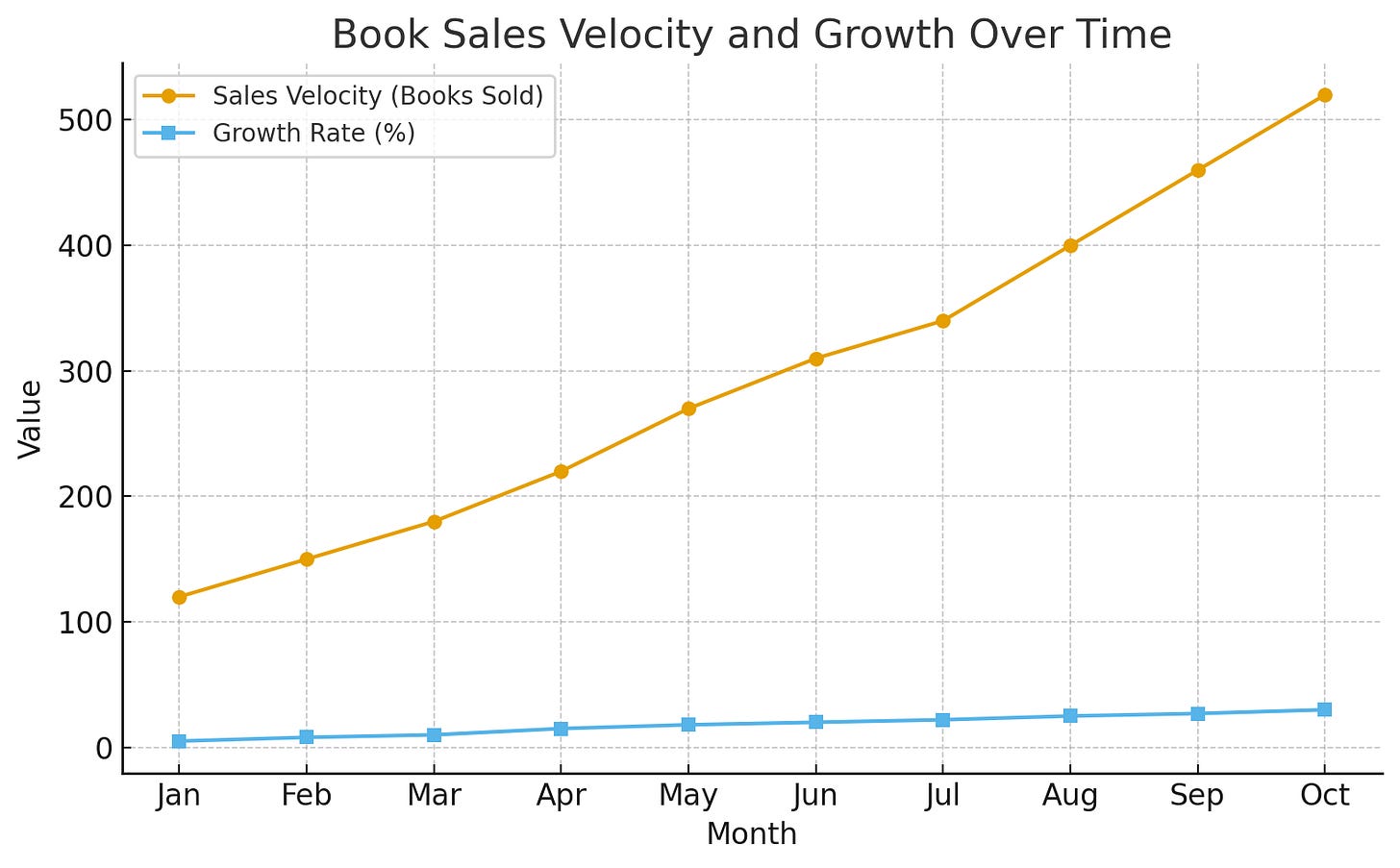Why Indie Authors Are Losing Sales Overnight
Amazon quietly rewired its system, and Joe Solari figured out how. Here’s what changed, what it means, and how to adapt fast.
Over the past few months, authors across every genre have noticed something strange happening on Amazon. Sales that used to be steady dropped to nothing. Page reads disappeared. Rankings froze in place. Nobody knew why.
Joe Solari was already deep into researching how Amazon’s system really works when this decline began. He manages millions in royalties for top-earning authors and studies the data that drives publishing success. His findings reveal major changes that might explain what so many authors are seeing right now.
Fair warning, his article The Hidden Rules of Amazon is a serious deep dive. It takes about two hours to read and is packed with data, research, and analysis. I am condensing the key points here, but I highly recommend reading it when you have time.
Here are nine insights that explain what changed inside Amazon and what it means for your author business.
#1 The 180-Day Shift
Most authors still believe Amazon ranks books based on what happens today or this week. They look at a spike in sales, see their rank climb, and assume the algorithm is paying attention right now.
That assumption is wrong.
Amazon changed the game when they began using a rolling 180-day average to measure performance. Every title is compared to itself and to every other book in the store across six months of data.
When a book jumps in rank on launch day, the algorithm notices for a moment before moving on. The system looks at the bigger picture and asks questions such as, “How steady is this book over time? Are readers still buying it three months later? Are people still reading it six months later?”
Amazon no longer chases quick wins. The company tracks long-term consistency.
Think of it like a fitness tracker. One intense workout will not change your average heart rate, but daily effort will. The algorithm behaves the same way. Steady sales, even in small numbers, carry more weight than a single spike that fades after a few days.
A book’s rank today reflects what happened weeks ago. Each day adds new data to the mix, and older data fades out. That constant churn makes performance feel unpredictable because every title competes against 180 days of storewide results that never stop shifting.
Many authors wonder why a new release drops off so quickly after launch. Amazon did not abandon them. The algorithm simply stopped providing the short-term boost and folded the book into the long-term comparison.
Here’s the takeaway: Treat every 180 days like a new report card. You are training the system with steady results. The more consistent your sales, the more confident Amazon becomes that your book belongs in front of readers. The algorithm does not reward flashes of attention. It rewards patterns it can trust.
#2 Sales Velocity vs. Consistency
For years, authors believed the key to visibility on Amazon was hitting hard at launch. Stack promotions, drive a flood of sales, spike your rank, and ride that wave for as long as possible.
That approach once worked, but not anymore.
The algorithm used to reward velocity, meaning how fast a book sold in a short window. Amazon later realized that sudden spikes often came from ads, giveaways, or tactics that did not reflect real reader demand. Those quick bursts rarely led to satisfied customers or long-term sales.
Consistency now beats velocity every time.
When Amazon sees a title perform at a steady pace, it treats that book as reliable. Reliability carries real value in the system. Amazon wants to recommend books that deliver ongoing engagement, not titles that burn bright and disappear.
This shift makes perfect sense. Amazon does not want to promote a book that only performed well for a few days. The system favors books that continue selling week after week because that steady performance says, “Readers like this, they finish it, and they come back for more.”
While many authors still try to “hack” the system with massive launch days, the smarter ones play the long game. They plan consistent release schedules that keep their audience engaged all year rather than chasing one big win.
Success is not about selling a thousand copies overnight. Real success is about selling a hundred copies each month for a year straight. That steady pattern teaches Amazon your book deserves a higher position in search and recommendation results.
If your goal is sustainability, avoid fireworks. Build a campfire that stays lit.
#3 Reading Matters More Than Buying
Every author focuses on sales. That makes sense because sales are the number everyone can see. Amazon, however, tracks something even more powerful than sales. The system monitors what happens after the sale.
Since 2016, Amazon has measured consumption as a core signal in its ranking system. The algorithm does not just ask, “Who bought this book?” It also asks, “Who actually read it?”
Downloads from free promotions or short-term sales blasts no longer carry much weight. When readers fail to open your book, turn the pages, or finish it, Amazon knows. Those unread files sitting on Kindles do not help your visibility. They quietly hurt it.
Amazon wants to connect readers with books they will love, not titles they will abandon. When a reader finishes your story, that completion data becomes a strong positive signal. It tells the system that your book satisfied the customer, and that is exactly what the algorithm aims to amplify.
Kindle Unlimited reads matter for the same reason. Each page read is a sign of engagement. Even if the royalties per page feel small, the true value lies in training the algorithm that your books deliver what readers want.
Clicks and purchases still matter, but the system watches long-term behavior. It measures how readers interact with your book, not just how many buy it during a promotion.
A marketing plan built entirely around giveaways or steep discounts often attracts readers who never finish the book. That kind of activity feeds the algorithm bad data and teaches Amazon that your title fails to satisfy buyers.
The fix is simple and powerful. Get your book into the hands of readers who will finish it. Build a stronger email list, target the right audience, and remove any misleading subtitles that attract the wrong crowd.
When Amazon sees that readers buy, read, and enjoy your book, the system starts finding more readers just like them. That is when the real growth begins, because the algorithm has learned you deliver on your promise.
#4 How Recommendations Actually Work
Many authors picture the algorithm as one giant machine making every decision. In reality, Amazon runs dozens of smaller systems that work together. Some operate in real time, while others process data over weeks or months.
Those systems power three main engines: search, recommendation, and ranking.
Search decides what appears when a reader types in keywords. Ranking determines the order of results. Recommendation, however, is where the real visibility happens.
Recommendations appear across nearly every corner of Amazon. They show up in the “customers who bought this also bought” section, on product pages, in email suggestions, and even inside shopping carts. This engine drives almost one-third of all page views on the site.
The recommendation system looks for patterns between readers and products. When readers who liked one book also buy another, Amazon links those titles together. Over time, these connections form an invisible web that guides what shoppers see. Each sale, click, and review strengthens those links.
Writing connected series or focusing on a single genre pays off because the overlap between titles becomes clearer. The algorithm can easily identify what kind of reader enjoys your work and recommend it to similar readers.
Jumping between unrelated genres or using too many pen names weakens that data. The algorithm struggles to define your audience, and your visibility suffers.
Make the system’s job easier. Keep your books connected by theme, tone, or genre. Encourage readers to move from one title to the next. Each transition tightens the network around your author brand and gives Amazon stronger proof that your catalog satisfies a specific audience.
Your consistency and focus feed the system the data it needs to promote you. The clearer that data, the more confidently Amazon can recommend your books to the right readers.
#5 Train the Algorithm, Don’t Trick It
Many authors still try to outsmart the algorithm. They buy click spikes, stack promotions, or send random traffic to their Amazon page hoping for quick results. That approach may create a temporary bump, but it teaches Amazon the wrong lesson.
The algorithm learns from data. Every click, purchase, and bounce is a signal. When you send cold traffic that does not convert, you tell Amazon that your book is not a good match for those shoppers. The system assumes something about the title or audience is off and moves on.
Low-converting traffic weakens your data for as long as 180 days. When too many visitors click without buying, the system records poor conversion and reduces how often your book appears in searches and recommendations. A smaller audience that consistently buys sends a much stronger signal.
Your goal is not to flood the system. Focus on feeding it reliable, positive data.
Start by warming up readers elsewhere. Build interest through your email list, Discord community, or social platforms. Let readers get to know you and your work before directing them to Amazon. When those warmed-up readers click through, they already trust you and are far more likely to buy.
That kind of high-conversion signal is what Amazon values most. The system can see that readers coming from your audience buy, read, and review. This process trains the algorithm to recognize your ideal reader and seek out more like them.
Amazon even provides a tool to help with this. Attribution links show the platform where your sales originate. Use them when running off-platform campaigns so Amazon can verify that your audience converts. That transparency improves your visibility over time.
Avoid hacks and shortcuts. The smartest strategy is to give Amazon consistent, truthful data. You are not gaming the system. You are teaching it who your readers are and why your books deserve to be seen.
A Quick, Relevant Interruption
So if you have been thinking about how to apply everything we have covered so far and build a real publishing system that works, now is the time to act.
I am wrapping up my Kickstarter campaign for The Final Three: Your Publishing Playbook, Rewritten. These are the last three books in the Self-Publishing with Dale series, completely rebuilt for today’s indie author world. They complete the twelve-book system that has helped thousands of authors publish smarter, earn more, and grow sustainable careers.
For the first time, all twelve books are available together in matching deluxe hardcovers with gold foil covers, sprayed edges, and a unified design. The Final Three feature new content, clear checklists, and refined strategies built for how publishing works right now.
But the biggest opportunity is coaching. For the first time in years, I reopened group coaching, and there are only twelve spots left. This is where we meet live, walk through your books, and create a clear plan so you stop guessing and start knowing what direction to go next. Every session gives you direct feedback, real strategies, and accountability that keeps you moving forward.
We are 370% funded, and the campaign ends at midnight tonight. The final stretch goal is a preloaded thumb drive filled with author tools and bonus resources.
If you want direct coaching, exclusive resources, and the newly rebuilt Final Three books that complete the Self-Publishing with Dale series, go to DaleLinks.com/Kickstarter. Payment plans are available, but only until midnight tonight.
#6 Ads Are Visibility, Not Magic
There was a time when authors could rely on organic reach to sell books on Amazon. That time has passed.
More than 80% of the first page of search results now features sponsored listings. On mobile devices, that number can reach one hundred percent. Without ads, most books remain invisible to shoppers.
Advertising is no longer optional; it’s part of the discovery system.
Many authors misunderstand how advertising works. They treat ads like an instant money machine, expecting every dollar spent to return profit immediately. When that fails to happen, they assume their ads failed too.
The real purpose of advertising is not short-term profit. The true goal is data. Ads help seed early sales and train the algorithm by showing Amazon who buys your book. Every click, sale, and read teaches the system more about your ideal reader.
When your ads reach the right people—those who buy, finish, and review—Amazon takes notice. Over time, your books begin to appear in more relevant searches and recommendation lists. The system learns that your titles satisfy readers in your niche, and that trust gives you visibility even when you are not actively running ads.
Think of advertising as fertilizer, not a harvest. Ads enrich the soil so your books can grow. The return builds gradually as your data matures and the algorithm gains confidence in your product.
The most effective authors use ads as part of a consistent rhythm. They do not overspend chasing spikes, and they do not panic when results take time. They understand that advertising powers Amazon’s discovery engine rather than functioning as a quick-cash slot machine.
Once you stop expecting advertising to make you rich overnight and start using it to strengthen your data, you will understand why it remains the most valuable visibility tool on the platform.
#7 The Author Brand Effect
Amazon tracks more than your books. The platform tracks your author brand.
Every title you publish builds a data trail around your pen name. The system tracks how readers respond to your catalog and connects sales, reviews, and read-through to form a behavioral profile of your work.
Strong and consistent data leads to more visibility. Scattered data causes your books to drop in visibility.
Authors who use multiple pen names or publish across unrelated genres confuse the algorithm. The system cannot determine which audience to associate with your work. That confusion results in weaker recommendations and lower placement.
A focused pen name builds authority. When every book under that name attracts the same kind of reader, Amazon quickly learns who you are and who to show your books to. The more data the system collects under one identity, the easier it becomes to connect your titles with the right audience.
Series writing strengthens this effect. Each new release reinforces the pattern between your books, your pen name, and your audience. The algorithm sees a clear loop of readers buying, reading, and reviewing across multiple titles.
Collaborative projects and anthologies can also strengthen your author data when managed strategically. Partnering with authors who share your audience creates crossover between fan bases and gives Amazon more positive associations to work with.
The goal is simple. Build a catalog that helps the system recognize your brand. Keep your genre tight, your tone consistent, and your pen name focused. Every clear signal helps Amazon position your work in front of the readers most likely to buy.
When you treat your pen name as a long-term asset rather than a one-time experiment, your entire catalog begins to rise together.
#8 Long-Term Game Plan
Every author wants quick results. You put in the work, publish the book, and hope it takes off. The truth is that Amazon rewards persistence, not luck.
Joe Solari’s research shows that real, lasting success takes time. On average, it takes three to five years and around ten to fifteen books before the algorithm begins working in your favor. That timeline might sound slow, but it is the most reliable way to build a career that lasts.
Amazon’s system is designed to recognize patterns. When you release books consistently, readers respond, and sales follow steady curves. Over time, the algorithm learns to trust your brand. It begins to see your books as a safe recommendation because your performance data remains reliable.
Sudden gaps in publishing can stall your progress. When sales stop for months at a time, the 180-day rolling window erases your previous performance. The system loses track of your momentum, and you have to rebuild it from scratch.
The authors who succeed long term are the ones who stay active. They publish regularly, keep their audience engaged, and treat every launch as another data point in a growing pattern of success.
Rapid release used to mean flooding the market, but now it means staying present. You do not need to publish a new book every month, but you do need a consistent rhythm that keeps your name visible and reminds Amazon that readers are still buying from you.
Building a sustainable author career on Amazon works like investing. The power does not come from one big deposit. The power comes from steady contributions that compound over time. Each new book strengthens your foundation and gives the system more proof that your work deserves to be recommended.
The long game is not about luck or shortcuts. The long game is about showing up, staying consistent, and giving the algorithm enough evidence to trust your brand.
#9 The Emotional Core
All the data, algorithms, and analytics in the world come down to one thing: emotion.
Readers buy because they feel something. They keep reading because your story connects with them. That emotional connection drives every number Amazon tracks.
When a reader finishes your book and feels moved enough to leave a review or buy your next title, that becomes the strongest signal you can send to the algorithm. The system learns that your work satisfies readers, and Amazon gains confidence recommending your book to others.
Strong storytelling always outperforms clever marketing. The authors who focus on mastering their craft, building real engagement, and delivering emotional satisfaction are the ones who rise to the top.
That connection cannot be faked or automated. When you achieve it, every other part of the system begins to work in your favor.
Your book does not just need to be seen. Your book needs to be felt.
Final Thoughts
At the end of the day, Amazon’s system isn’t broken, it’s evolving. And the authors who understand how it really works will come out ahead.
What Joe Solari uncovered isn’t the end of opportunity for indie authors. It’s a new beginning for the ones who adapt. Shout-out to Joe for writing such a thoroughly researched piece. Make sure you give it a full read here. If you want to know where else you can publish beyond Amazon, this previous post about the 10 best places to self-publish (see below). I’ll see you there.













Lots of interesting information here, but I'm coming away feeling a bit disheartened. I started publishing in 2021 and now have 13 titles released, so I feel like I should be doing better by now.
Any tips on how to find our audience? I'm obviously not looking in the right place. Or maybe I'm simply writing in a genre that nobody wants anymore. I can barely give copies away!
A fantastic read. I, like I'd assume many others, have been guilty of focusing on quantity and a race to the bottom in the past. From my learnings over the years though it is incredibly clear that quality is more important than ever than quantity when it comes to achieving real results on KDP over the long-term.